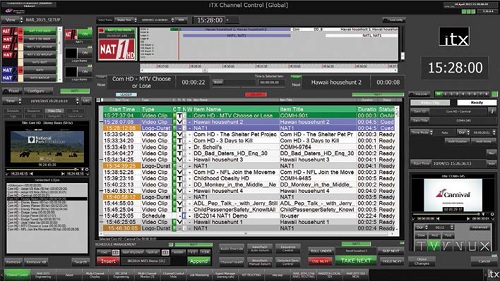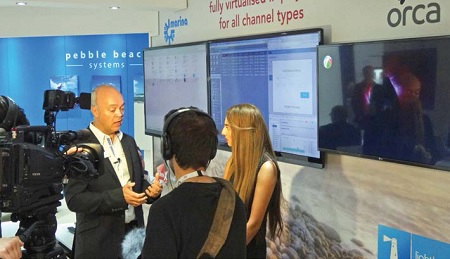Integrated Channel Playout Speeds Shift to IP
HAMILTON, N.J.— The shift from baseband SDI to an IP model based on off-the-shelf servers is very complex, especially if you factor in other looming trends like 4K and private data cloud migration.
Nowhere is the pressure being felt more than in master control, which delivers the programs and commercials that generate the revenue. Integrated Channel Playout (ICP) and Channel-in-a-Box (CIAB) systems are taking over due to their unprecedented operational flexibility and cost-efficiency. Many of the latest ICP and CIAB systems offer both IP and SDI I/O connectivity to ease the transition.

Grass Valley’s iTX channel gridTWO TERMS, TWO DIFFERENCES
The terms ICP and CIAB are often used interchangeably, but there is a difference, according to Andy Warman, director of production and playout strategy and market development for Harmonic in San Jose, Calif., “CIAB is a self-contained ecosystem where all the functions to run and playout one or more channels are contained in one box,” he said. But, “when the workflow is more complex, and you need centralized management and monitoring, that’s where you’re going to use ICP systems. If the facility needs to handle many upstream processes, such as integration to an archive, recording via baseband and quality control as well as playout, this broader requirement goes beyond what can be accommodated in a CIAB.”
Harmonic’s product line includes both types of systems, including Polaris Play, which is targeted at CIAB; and Polaris Advance and Polaris Elite, which are designed for ICP systems. When paired with Harmonic’s Spectrum MediaDeck 7000 integrated media server, Polaris Play automates playout of up to four SD/HD channels, each with its own SD simulcast channel for a total of eight channels per 1RU. And when Spectrum servers are used with Polaris Advance and Elite, this solution spans ingest, archiving, playlist management, media prep, traffic integration and scheduled and live playout.
Another Harmonic product, Spectrum X, is an advanced media server that enables broadcasters to migrate from SDI to IP workflows for both CIAB and ICP systems, and includes graphic branding, DVE and live switching of HD/SD-SDI (3G) baseband and IP I/O sources.
“Many broadcasters are still using SDI workflows, but at some point they’ll be moving to IP, and Spectrum X bridges the gap because it supports SDI and IP connectivity in a single box,” Warman said. “This allows broadcasters to keep parts of their plant SDI, while other parts are IP. Then, as their workflow needs and budgets change, they can fully transition to IP when they’re ready.”
HYBRID WORLD
“This transition to ICP is happening because it’s more economical than running a physical transmission chain with different brand boxes that are complex to maintain and consume lots of space and power,” said Scott Rose, director of product marketing for iTX for Grass Valley. “It’s not like broadcasters will just flip a switch and now their stations are IP-only. They still need to stay on the air, running in mixed IP/SDI mode, with all the standards and functionality that make our business uniquely broadcast television.”
The professional video industry's #1 source for news, trends and product and tech information. Sign up below.
When broadcasters are ready to move to integrated playout, Rose said they should ask themselves: Does this solution enable frame-accurate switching in IP that’s as good as we’ve come to expect from a baseband router? The SMPTE 2022-6 standard, approved in 2013, enables high-bandwidth IP with deterministic switching and Grass Valley supports the standard throughout its iTX automated integrated playout product line.
“Just because our industry is moving to IP doesn’t mean we want to give up frame-accurate switching, broadcast quality video and graphics, closed captioning, loudness controls, and other standards viewers have come to expect,” Rose said. He added that reliability is also key, with Grass Valley iTX systems successfully playing out 17.5 million hours of broadcast television this year, including $8 million worth of commercials on Oscars night.

Steve SmithOPERATIONAL FLEXIBILITY
“Outside the walls of the TV station, our world is already IP, and what we’ve done is allowed it to come all the way into our facilities and cloud environments,” said Steve Smith, chief technology officer for Cloud technology at Imagine Communications, in Frisco, Texas. “ICP systems, such as our Versio system, enable purely IP, software-based master control.”
Versio can virtualize the entire workflow from contribution to distribution, including master control tasks like video playout, graphics and branding, live caption insertion, switching, routing and digital signal processing. And a higher layer of automation called orchestration can manage Versio along with all the other virtualized systems across the IP workflow. Disney/ABC Television Group, which announced a deal with Imagine at the 2015 NAB Show to move to an all IP infrastructure, is among the many broadcast organizations that have adopted Versio.
“ICP makes master control more resilient while shrinking the physical footprint needed to support playout,” Smith added. “Lower cost, generic IT systems can provide any business function needed depending upon the software applied to them.” Smith calls this operational flexibility— including readily changing the business functions supported and scaling the entire platform up or down— “virtualization.”
ORCHESTRATING CHANGE
Pebble Beach Systems has virtualized the entire air chain into their Orca CIAB, which is a fully IP-enabled device that offers the feature set of its SDI counterpart, Dolphin. According to Eric Openshaw general manager for North America for the Denver-based company, Orca, which was launched at the IBC Show in September, is designed for large-scale deployments where customers with enterprise virtualized server platforms can host playout services on their own infrastructure, often along with other virtual machines they may run.
“Virtualization and our dedicated deployment tools make it possible to ramp up a new broadcast channel in just minutes, without the significant capital outlay and technical barriers associated with installing specialized boxes and cabling,” he said. “This gives broadcasters an increased level of agility because they can quickly set up a new channel, or even a temporary channel, just to see if it appeals to viewers since they wouldn’t have to expand their physical infrastructure to do so.”

Pebble Beach Systems launched its Orca CiaB system at the 2015 IBC Show. Virtualization coupled with an IT infrastructure makes it more practical to move some or all of master control to a private cloud, he adds.
Orca is driven by another Pebble Beach Systems product, Marina, which serves as the orchestration layer. While the CIAB largely handles air chain functions, “the orchestration layer automates a broader range of upstream tasks, such as managing files, assets and metadata, as well as the CIAB itself,” Openshaw said.
For SDI facilities, the company offers the Dolphin CIAB, which includes an SDI video card and optional IP inputs and outputs. Scripps Networks Interactive has purchased Marina and 31 Dolphin CIAB systems for its Knoxville, Tenn. BOC, plus 11 for off-site disaster recovery.
THE NEED FOR STANDARDS
By around 2020, we should see an end-to-end IP infrastructure in broadcast, according to Karl Mehring, director of playout and delivery for Snell Advanced Media in the U.K. “Until then, we’ll have islands of SDI due to interoperability issues and non-standardization.”
Mehring said that the broadcast industry is unique in its need for a continuous stream of data and “five nines” of reliability—a tall order in today’s IP domain. “As long as we drive the various standards in the right way, become very IP savvy, and build sufficient redundancy around playout, master control will be as reliable in IP as SDI,” he said.
Two standards—SMPTE 2022-6 for sending uncompressed SDI over IP and SMPTE 2022-2 for compressed video—have begun to address the challenges in the short term. “The remaining interoperability issues will be resolved by newly ratified standards,” Mehring said, “but until then, we’ll need to accept a hybrid world.” SAM offers ICE CIAB systems with SDI and IP functionality as well as ICE SDC, a software only playout solution.
THE MODULAR ROUTE
Miami-based Primestream’s Fork Suite of applications consists of modules, with automated functionality that spans the gamut from broadcast acquisition to playout and OTT delivery. These modules include Fork Playout, Fork Live Assist and Fork MAM, among other broadcast management tools.
“Our focus is on making manufacturer-agnostic software, allowing customers to choose best-in-class components and configurations that are right for their unique workflows,” said Chief Operating Officer David Schleifer. “Our product is designed to serve as the glue in the midst of key production and playout processes.”
FORK software can be implemented as an adjunct to existing third-party equipment, such as playout servers, storage systems and even integrated playout systems. Or it can serve as a full-featured, automated, integrated playout solution that supports industry protocols and leverages generic, IT servers and video cards for flexibility and cost-efficiency.
CIAB FOR LPTV
One market segment that’s traditionally been priced out of technological advances, like CIAB, is low-power TV and Class A stations. Dallas-based RUSHWORKS stepped up to remedy the situation, and make CIAB affordable to these stations with its A-LIST broadcast automation CIAB, which supports up to four SD and HD I/O channels per chassis.
“We saw an opportunity to serve LPTV stations, as well as Class A and full-power stations, by developing a full-featured CIAB that enables these price-conscious customers to adopt new technology at a price point that better allows them to make a return on investment,” said company President Rush Beesley. Along with A-LIST’s powerful yet simple interface, the price point makes it equally attractive for government, educational and independent channels.
A-LIST lets broadcasters distribute signals to a broad range of platforms simultaneously, including traditional TV, Internet sites, OTT services like Roku, and cable head-ends. HD and SD formats are supported along with a mix of popular file formats, such as MPEG-2, H.264, MXF, MOV and AVI.
“Our architecture performs SD/HD up/down conversion in real time during playout,” Beesley said. “Because we support multiple formats, users can drop all their content into the automated playlist without the additional process and expense of using file-conversion software to prep the files for playback.”
Multichannel HD A-LIST systems are installed in master control facilities at Christian Broadcasting Network and KTNC-TV/San Francisco, an NRJ station.

